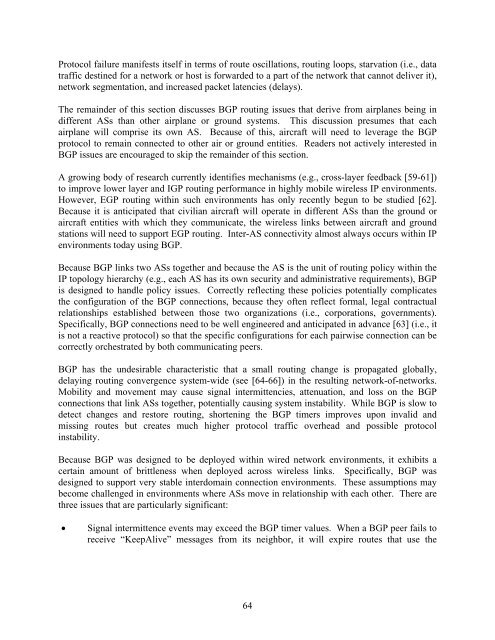Local Area Networks (LANs) in Aircraft - FTP Directory Listing - FAA
Local Area Networks (LANs) in Aircraft - FTP Directory Listing - FAA
Local Area Networks (LANs) in Aircraft - FTP Directory Listing - FAA
You also want an ePaper? Increase the reach of your titles
YUMPU automatically turns print PDFs into web optimized ePapers that Google loves.
Protocol failure manifests itself <strong>in</strong> terms of route oscillations, rout<strong>in</strong>g loops, starvation (i.e., data<br />
traffic dest<strong>in</strong>ed for a network or host is forwarded to a part of the network that cannot deliver it),<br />
network segmentation, and <strong>in</strong>creased packet latencies (delays).<br />
The rema<strong>in</strong>der of this section discusses BGP rout<strong>in</strong>g issues that derive from airplanes be<strong>in</strong>g <strong>in</strong><br />
different ASs than other airplane or ground systems. This discussion presumes that each<br />
airplane will comprise its own AS. Because of this, aircraft will need to leverage the BGP<br />
protocol to rema<strong>in</strong> connected to other air or ground entities. Readers not actively <strong>in</strong>terested <strong>in</strong><br />
BGP issues are encouraged to skip the rema<strong>in</strong>der of this section.<br />
A grow<strong>in</strong>g body of research currently identifies mechanisms (e.g., cross-layer feedback [59-61])<br />
to improve lower layer and IGP rout<strong>in</strong>g performance <strong>in</strong> highly mobile wireless IP environments.<br />
However, EGP rout<strong>in</strong>g with<strong>in</strong> such environments has only recently begun to be studied [62].<br />
Because it is anticipated that civilian aircraft will operate <strong>in</strong> different ASs than the ground or<br />
aircraft entities with which they communicate, the wireless l<strong>in</strong>ks between aircraft and ground<br />
stations will need to support EGP rout<strong>in</strong>g. Inter-AS connectivity almost always occurs with<strong>in</strong> IP<br />
environments today us<strong>in</strong>g BGP.<br />
Because BGP l<strong>in</strong>ks two ASs together and because the AS is the unit of rout<strong>in</strong>g policy with<strong>in</strong> the<br />
IP topology hierarchy (e.g., each AS has its own security and adm<strong>in</strong>istrative requirements), BGP<br />
is designed to handle policy issues. Correctly reflect<strong>in</strong>g these policies potentially complicates<br />
the configuration of the BGP connections, because they often reflect formal, legal contractual<br />
relationships established between those two organizations (i.e., corporations, governments).<br />
Specifically, BGP connections need to be well eng<strong>in</strong>eered and anticipated <strong>in</strong> advance [63] (i.e., it<br />
is not a reactive protocol) so that the specific configurations for each pairwise connection can be<br />
correctly orchestrated by both communicat<strong>in</strong>g peers.<br />
BGP has the undesirable characteristic that a small rout<strong>in</strong>g change is propagated globally,<br />
delay<strong>in</strong>g rout<strong>in</strong>g convergence system-wide (see [64-66]) <strong>in</strong> the result<strong>in</strong>g network-of-networks.<br />
Mobility and movement may cause signal <strong>in</strong>termittencies, attenuation, and loss on the BGP<br />
connections that l<strong>in</strong>k ASs together, potentially caus<strong>in</strong>g system <strong>in</strong>stability. While BGP is slow to<br />
detect changes and restore rout<strong>in</strong>g, shorten<strong>in</strong>g the BGP timers improves upon <strong>in</strong>valid and<br />
miss<strong>in</strong>g routes but creates much higher protocol traffic overhead and possible protocol<br />
<strong>in</strong>stability.<br />
Because BGP was designed to be deployed with<strong>in</strong> wired network environments, it exhibits a<br />
certa<strong>in</strong> amount of brittleness when deployed across wireless l<strong>in</strong>ks. Specifically, BGP was<br />
designed to support very stable <strong>in</strong>terdoma<strong>in</strong> connection environments. These assumptions may<br />
become challenged <strong>in</strong> environments where ASs move <strong>in</strong> relationship with each other. There are<br />
three issues that are particularly significant:<br />
• Signal <strong>in</strong>termittence events may exceed the BGP timer values. When a BGP peer fails to<br />
receive “KeepAlive” messages from its neighbor, it will expire routes that use the<br />
64
















